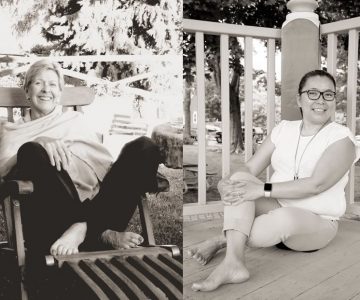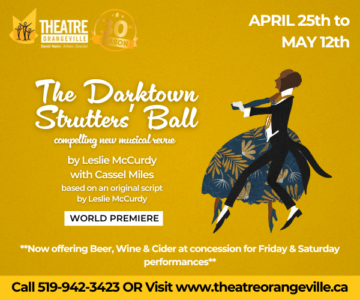Orangeville Otters Swim Club
Otters in the Waters: The pool isn’t just for kids.
Sixteen-year-old Penny Oleksiak became a household name after her impressive performance in the pool at the 2016 Olympic Games in Rio de Janeiro. She was the first Canadian to win four medals at a summer Olympics and the youngest Canadian to become an Olympic champion. Across the nation, Oleksiak’s success inspired swimmers of all ages, including members of Orangeville’s Otters Swim Club.
Despite Oleksiak’s fame and although swimming has been an Olympic sport at every modern Summer Games, people often think of swimming not so much as a high performance sport, but more a childhood rite of passage – something everyone has to learn like arithmetic and tying your shoes. Erin Woodley knows otherwise. A Headwaters resident (and sales manager for this magazine), Erin won a silver medal in synchronized swimming at the 1996 Olympic Games in Atlanta.
Consumed by her sport throughout her youth, Erin retired from competition believing she’d never want to get wet again. Yet in 2015, she began swimming in the masters program with the Otters Swim Club. Erin recalls, “When I walked into the pool and smelled the chlorine, my heart started to flutter.” Now she trains with a coach, who leads the masters swimmers (adults 18 and over) through a series of drills that improve cardio, strength and strokes. But the lure of competition beckons the Olympian. Erin says that someday she’d like to enter a competition again.

Left to right : Enthusiastic master swimmers Sherri Curry, Melody Wiseheart, Stephanie Sostar, Kimberly McGowan and Jo Coburn. Photo by Rosemary Hasner / Black Dog Creative Arts.
In order to keep up with demand, the Otters Swim Club has eight paid coaches. There are programs for every age group from toddlers, kids and teenagers to masters swimmers who can train up to 6.5 hours a week. Some members use their swim time as a form of fitness and/or fun; others want to compete – and then there’s Kimberly McGowan.
A 21-year veteran of the Otters Club, Kimberly gets into the pool as often as she can. She doesn’t just train with the masters, she races in three or four competitions each year and coaches other swimmers several times a week. Kimberly says, “I plan to keep swimming until I can’t get out of the pool any longer.” It’s a sport she took to from before the beginning. “My mother told me that when her water broke, I came out in a wave.” After Kimberly’s fascination with water resulted in her almost drowning twice, her mother enrolled her young “hellion” in lessons. Kimberly never looked back. Her career highlight was in 2013 when she won three medals at provincial masters championships placing in the top eight in all five of the events she entered.
Kimberly says the Otters are like a big family, but that’s not all that attracts her. She says, “I like pushing myself and I love the competition.”
A competitive spirit also drives Rob Taylor, the Otters’ head coach since 2016. Rob, who had won several provincial championships, made the Olympic team for the 2000 Sydney Olympic Games while still at Brampton Centennial Secondary School. This climax to his swimming career came naturally to the six-foot-five-inch, six-foot-nine-and-a-half-inch-winged, freestyle specialist. By age six, he’d have completed the entire Red Cross swimming program except that he was unable to fulfill the required element of picking up a brick from the bottom of the pool. “I failed my maroon level three times because I was too little to lift that brick,” he says.
Rob is a busy guy in the head coach role. Along with the seven other coaches under his supervision, including assistant coach and local triathlete Richard Pady, he teaches, drills and counsels 125 competitive swimmers, 40 non-competitive ones as well as 15 masters, including Kimberly and Erin. Rob misses spending more time in the water, but, he says, “After giving up competitive swimming, I realized that I enjoyed coaching and had something to give.” Rob’s enthusiasm, combined with inspirations like Penny Oleksiak, accounts for the club’s swelling ranks. Erin says, “The masters’ program has opened up since Rob became head coach.”
Meanwhile, Erin is trying her hand at coaching, too. She voluntarily set up a program for local swimmers with intellectual disabilities in conjunction with the Dufferin chapter of Special Olympics Ontario. Now in its second year, the number of people taking part in the Town of Orangeville-supported initiative has doubled.
Headwaters also boasts an inspiring Paralympian. At 17, Tess Routliffe, a Caledon resident who grew up training with the Dorado Stars Swim Club, won four gold medals for her swimming prowess at the 2015 Parapan American Games in Toronto and took silver at the 2016 Rio Paralympics. Like Oleksiak, Tess raised the profile of a sport that often takes a back seat to soccer or hockey or baseball.
Developing and coaching stars gets attention, but Erin, Kimberly and head coach Rob have channelled much of their competitive energy into assisting others to achieve their swimming goals, however modest. Rob, whose tall and lanky bearing is a regular fixture on Orangeville’s pool decks, says he loves being part of a group of motivated people.
Though pools tend to be populated by youngsters, swimming is also a great sport for adults. It’s easier on your joints than tennis or squash and it requires using virtually every muscle in your body, so it’s a thorough workout. As she pulls down her googles and slides into the pool, Kimberly says, “It’s something you can do for your entire life.”
Swimming Facts
- Freedivers can hold their breath for as long as 10 minutes.
- The oldest stroke is the breaststroke.
- Swimmers sweat in the pool.
- New Canadians (19 per cent) are over four times more likely to be unable to swim than those born in Canada (4 per cent).
- Swimming became an Olympic sport in 1908, but women couldn’t participate until 1912.
- Competitive swimmers often shave their entire bodies. It is reported to make swimmers better able to feel the water.
- Swimmers use nearly every muscle in their bodies.
- The word bikini is named after the Bikini Atoll, a nuclear test site.
(Adapted from Swimming World Magazine and the Lifesaving Society)
Related Stories

Swimming Buddies: Virginia Ridpath and Richie Castillo
Jun 19, 2018 | | LeisureA former Olympic swimmer and her Philippines-born caregiver swam together for less than a year – but the experience changed both their lives profoundly.









